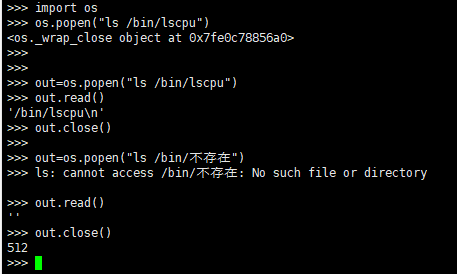Python调用Shell命令 (python,shell 混合编程)
Python经常被称作“胶水语言”,因为它能够轻易地操作其他程序,轻易地包装使用其他语言编写的库,也当然可以用Python调用Shell命令。
用Python调用Shell命令有如下几种方式:
1. os.system
os.system("The command you want").
os.system("lscpu").
os.system("ls -al").
这个调用相当直接,且是同步进行的,程序需要阻塞并等待返回。返回值是依赖于系统的,直接返回系统的调用返回值,所以windows和linux是不一样的。
2. os.popen
os.popen(command[,mode[,bufsize]])

可以看出,popen方法通过p.read()获取终端输出,而且popen需要关闭close().当执行成功时,close()不返回任何值,失败时,close()返回系统返回值. 可见它获取返回值的方式和os.system不同。
3. 使用commands ( python3失效)
根据你需要的不同,commands模块有三个方法可供选择。getstatusoutput, getoutput, getstatus。
commands.getstatusoutput(cmd) 返回(status, output).
commands.getoutput(cmd) 只返回输出结果
commands.getstatus(file) 返回ls -ld file的执行结果字符串,调用了getoutput,不建议使用此方法
但是,如上三个方法都不是Python推荐的方法,而且在Python3中其中两个已经消失。
4. subprocess《Python文档中目前全力推荐》
subprocess使用起来同样简单:
直接调用命令,返回值即是系统返回。shell=True表示命令最终在shell中运行。Python文档中出于安全考虑,不建议使用shell=True。建议使用Python库来代替shell命令,或使用pipe的一些功能做一些转义。官方的出发点是好的,不过真心麻烦了很多, so....
但是,我使用subprocess失败了
>>> import subprocess
>>> subprocess.call("cat %s |grep %s > %s " % ("/home/www/running/os-app-api/nohup.out","2019-10-28","~/nohup-2019-10-28.out"))
Traceback (most recent call last):
File "<stdin>", line 1, in <module>
File "/usr/lib64/python3.6/subprocess.py", line 287, in call
with Popen(*popenargs, **kwargs) as p:
File "/usr/lib64/python3.6/subprocess.py", line 729, in __init__
restore_signals, start_new_session)
File "/usr/lib64/python3.6/subprocess.py", line 1364, in _execute_child
raise child_exception_type(errno_num, err_msg, err_filename)
FileNotFoundError: [Errno 2] No such file or directory: 'cat /home/www/running/os-app-api/nohup.out |grep 2019-10-28 > ~/nohup-2019-10-28.out ': 'cat /home/www/running/os-app-api/nohup.out |grep 2019-10-28 > ~/nohup-2019-10-28.out '

但是,可以直接运行在shell里面:

同样的 我用os.system 去运行,也确实产生了。
>>> import os
>>> os.system("cat %s |grep %s > %s " % ("/home/www/running/os-app-api/nohup.out","2019-10-28","~/nohup-2019-10-28.out"))
256
源码研究:

这里面最为重要的几个参数是:.
args:要执行的shell命令,或者是命令的列表;
bufsize:缓冲区大小;。
stdin、stdout、stderr:表示程序的标准输入、标准输出以及错误输出。
shell:是否直接执行命令,如果设置为True就表示可以直接执行;
cwd:当前的工作目录;
env:子进程环境变量;

subprocess模块里面还有一项功能比较强大的支持在于可以直接使用标准输入、标准输出和错误输出进行进程的数据通讯操作。
例如,在Python安装完成之后都会存在有交互式的编程环境,那么本次将通过程序调用交互式编程环境直接操作python命令行,在python命令行中直接输入程序。
def main():
subp_popen=subprocess.Popen("python.exe",stdin=subprocess.PIPE,stdout=subprocess.PIPE,stderr=subprocess.PIPE)
subp_popen.stdin.write("print('subp_popen.stdin.write1')
".encode())
subp_popen.stdin.write("print('subp_popen.stdin.write2')
".encode())
subp_popen.stdin.write(("print('subp_popen.stdin.write3'+1)").encode())
subp_popen.stdin.close()
cmd_out=subp_popen.stdout.read()
subp_popen.stdout.close()
print(cmd_out.decode())
cmd_err=subp_popen.stderr.read()
subp_popen.stderr.close()
print(cmd_err)
if __name__ == '__main__':
main()
